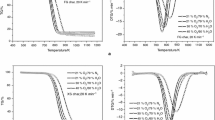Abstract
The thermal characteristics of pulverized coal have been studied under oxy-fuel combustion conditions using non-isothermal thermogravimetric analysis (TG). The atmospheres used were 21%O2/79%N2, 21%O2/79%CO2, 30%O2/70%O2, and 35%O2/65%CO2. Coal blends of coal with 10 and 20% of biomass were also studied under these atmospheres. The addition of 10 and 20% of steam was evaluated for the oxy-fuel combustion atmospheres with 21 and 30% of O2 in order to study the effect of the wet recirculation of flue gas. The results obtained were similar for all the different rank coals and indicated that replacing N2 by CO2 in the combustion atmosphere with 21% of O2 caused a slight decrease in the rate of mass loss and delayed the burning process of the coal, biomass and coal/biomass blend samples. When the O2 concentration was increased to 30 and 35% in the oxy-fuel combustion atmosphere, the rate of mass loss increased, the burning process occurred at lower temperatures and it was shorter in duration. An increase in the rate of mass loss and a reduction in burning time and temperature were observed after the addition of steam to the oxy-fuel combustion atmosphere. No relevant differences between the 10 and 20% steam concentrations were observed.



Similar content being viewed by others
References
BP 2009. BP statistical review of world energy June 2009. http://www.bp.com. Accessed 22 Nov 2010.
Buhre BJP, Elliott LK, Sheng CD, Gupta RP, Wall TF. Oxy-fuel combustion technology for coal-fired power generation. Prog Energy Combust Sci. 2005;31:283–307.
Bejarano PA, Levendis YA. Single-coal-particle combustion in O2/N2 and O2/CO2 environments. Combust Flame. 2008;153:270–87.
Rathnam RK, Elliott LK, Wall TF, Liu Y, Moghtaderi B. Differences in reactivity of pulverised coal in air (O2/N2) and oxy-fuel (O2/CO2) conditions. Fuel Process Technol. 2009;90:797–802.
Toftegaard MB, Brix J, Jensen PA, Glarbor P, Jensen AD. Oxy-fuel combustion of solid fuels. Prog Energy Combust Sci. 2010;36:581–625.
Li Q, Zhao C, Chen X, Wu W, Li Y. Comparison of pulverized coal combustion in air and in O2/CO2 mixtures by thermo-gravimetric analysis. J Anal Appl Pyrolysis. 2009;85:521–8.
Molina A, Shaddix CR. Ignition and devolatilization of pulverized bituminous coal particles during oxygen/carbon dioxide coal combustion. Proc Combust Inst. 2007;31:1905–12.
Huang X, Jiang X, Han X, Wang H. Combustion characteristics of fine- and miro-pulverized coal in the mixture of O2/CO2. Energy Fuels. 2008;22:3756–62.
Li X, Rathnam RK, Yu J, Wang Q, Wall T, Meesri C. Pyrolysis and combustion characteristics of an Indonesian Low-Rank Coal under O2/N2 and O2/CO2 conditions. Energy Fuels. 2010;24:160–4.
Liu H, Zailani R, Gibbs BM. Comparisons of pulverized coal combustion in air and in mixtures of O2/CO2. Fuel. 2005;84:833–40.
Várhegyi G, Szabó P, Jakab E, Till F. Mathematical modeling of char reactivity in Ar-O2 and CO2–O2 mixtures. Energy Fuels. 1996;10:1208–14.
Zhang L, Binner E, Qiao Y, Li C-Z. In situ diagnostics of Victorian brown coal combustion in O2/N2 and O2/CO2 mixtures in drop-tube furnace. Fuel. 2010;89:2703–12.
Nozaki T, Takano S, Kiga T, Omata K, Kimura N. Analysis of the flame formed during oxidation of pulverized coal by an O2-CO2 mixture. Energy. 1997;22:199–205.
Arias B, Pevida C, Rubiera F, Pis JJ. Effect of biomass blending on coal ignition and burnout during oxy-fuel combustion. Fuel. 2008;87:2753–9.
Pis JJ, de la Puente G, Fuente E, Morán A, Rubiera F. A study of the self-heating of fresh and oxidized coals by differential thermal analysis. Thermochim Acta. 1996;279:93–101.
Rubiera F, Morán A, Martínez O, Fuente E, Pis JJ. Influence of biological desulphurisation on coal combustion performance. Fuel Process Technol. 1997;52:165–73.
Niu SL, Lu CM, Han KH, Zhao JL. Thermogravimetric analysis of combustion characteristics and kinetic parameters of pulverized coals in oxy-fuel atmosphere. J Therm Anal Calorim. 2009;98:267–74.
Arenillas A, Rubiera F, Pis JJ, Jones JM, Williams A. The effect of the textural properties of bituminous coal chars on NO emissions. Fuel. 1999;78:1779–85.
Jiang XM, Cui ZG, Han XX, Yu HL. Thermogravimetric investigation on combustion characteristics of oil shale and high sulphur coal mixture. J Therm Anal Calorim. 2006;85:761–4.
Buryan P, Staff M. Pyrolysis of the waste biomass. J Therm Anal Calorim. 2008;93:637–40.
Mothé CG, de Miranda IC. Characterization of sugarcane and coconut fibers by thermal analysis and FTIR. J Therm Anal Calorim. 2009;97:661–5.
Slovák V, Taraba B. Effect of experimental conditions on parameters derived from TG-DSC measurements of low-temperature oxidation of coal. J Therm Anal Calorim. 2010;101:641–6.
Cumming JW, McLaughlin J. The thermogravimetric behaviour of coal. Thermochim Acta. 1982;57:253–72.
Rubiera F, Arenillas A, Arias B, Pis JJ. Modification of combustion behaviour and NO emissions by coal blending. Fuel Process Technol. 2002;77:111–7.
ASTM Standard D 388. Standard classification of coals by rank; 2005.
Rubiera F, Arenillas A, Fuente E, Miles N, Pis JJ. Effect of the grinding behaviour of coal blends on coal utilisation for combustion. Powder Technol. 1999;105:351–6.
Haykırı-Açma H. Combustion characteristics of different biomass materials. Energy Convers Manage. 2003;44:155–62.
Zheng JA, Koziński JA. Thermal events occurring during the combustion of biomass residue. Fuel. 2000;79:181–92.
Gil MV, Casal D, Pevida C, Pis JJ, Rubiera F. Thermal behaviour and kinetics of coal/biomass blends during co-combustion. Bioresour Technol. 2010;101:5601–8.
Kastanaki E, Vamvuka D. A comparative reactivity and kinetic study on the combustion of coal-biomass char blends. Fuel. 2006;85:1186–93.
Khare SP, Wall TF, Farida AZ, Liu Y, Moghtaderi B, Gupta RP. Factors influencing the ignition of flames from air-fired swirl pf burners retroffited to oxy-fuel. Fuel. 2008;87:1042–9.
Acknowledgements
This study was carried out with financial support from the Spanish MICINN (Project PS-120000-2005-2) co-financed by the European Regional Development Fund. L.A. and J.R. acknowledge funding from the CSIC JAE program, which was co-financed by the European Social Fund, and the Asturias Regional Government (PCTI program), respectively.
Author information
Authors and Affiliations
Corresponding author
Rights and permissions
About this article
Cite this article
Gil, M.V., Riaza, J., Álvarez, L. et al. A study of oxy-coal combustion with steam addition and biomass blending by thermogravimetric analysis. J Therm Anal Calorim 109, 49–55 (2012). https://doi.org/10.1007/s10973-011-1342-y
Received:
Accepted:
Published:
Issue Date:
DOI: https://doi.org/10.1007/s10973-011-1342-y




